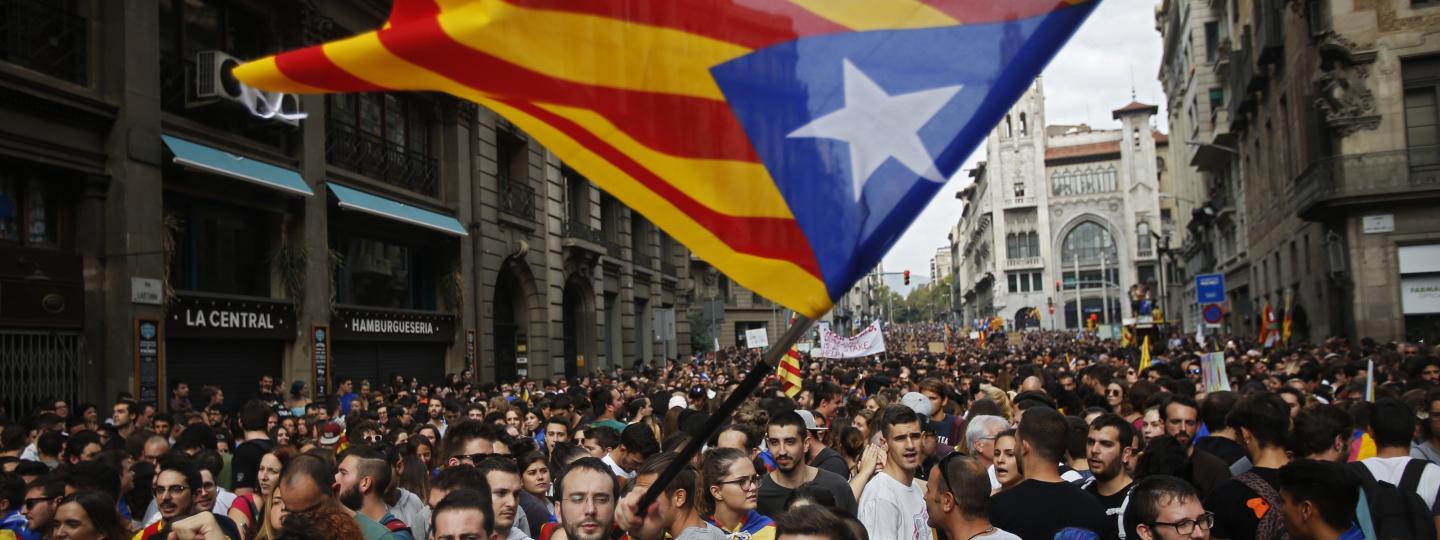It wasn’t long after Catalonia voted for independence that fake news and online hoaxes started to spread — often taking aim at either the police or protesters disputing the outcome.
During the Catalan referendum Sunday, the Spanish Civil Guard and National Police Corps converged on Barcelona to crack down on polling stations and calls for independence, which the country’s highest court deemed illegal on Sept. 20. Local officials estimated that about 800 civilians were injured in the weekend’s violence — during which police fired rubber bullets and beat back voters with batons — while the government estimated more than 400 police officers had been injured as of Tuesday.
Amid the chaos, Clara Jiménez Cruz, founder of independent Spanish fact-checking outfit Maldito Bulo, has been tracking viral hoaxes about the police presence in Barcelona. Misinformation shared on Twitter, Facebook and WhatsApp in the past several days includes old images depicting bloodied protesters and false stories about dead police officers.
“We’ve seen a lot of fake pictures on people who have been hurt by the police, but were really pictures from different demonstrations,” said Cruz, who also works as a journalist for the Madrid-based El Objetivo prime time news show on La Sexta (Maldito Bulo occasionally collaborates with El Objetivo). “Because Catalonia has their own police, the Spanish police going to Catalonia was a pretty big deal.”
Falsehoods about the Catalan referendum haven’t been isolated to only one side, either — both pro-independence and anti-independence sympathizers have shared fake news in the past few days. Poynter caught up with Cruz to see which hoaxes gained the most traction; they’re broken up into categories below.
Pro-independence
Most of the hoaxes in favor of Sunday’s referendum have focused on false incidents of police brutality against citizens in Catalonia.
Several photos from a 2012 miners’ protest in Madrid have circulated on Twitter under the guise of injured Catalan civilians, which were quickly debunked by Maldito Bulo. The independent organization launched in January and superimposes corrections on false images.
NO.
Esta foto no es de hoy.
Es de 2012 durante las cargas policiales contra las protestas de los mineros en Madrid. pic.twitter.com/TBCB6fLBKf
— MALDITO BULO (@malditobulo) October 1, 2017
NO.
Esta foto de un niño agredido no es de hoy.
Es de 2012. Los Mossos le golpearon en la manifestación de la huelga general. pic.twitter.com/TNhklJJDaW
— MALDITO BULO (@malditobulo) October 1, 2017
The online preoccupation with police brutality has even expanded into hoaxes about undercover cops. Maldito Bulo debunked one image of a man named Pep Escobedo, which was shared on Facebook with a caption warning people he was a police officer. In fact, Escobedo is a pro-independence civilian.
NO.
El supuesto infiltrado en las manifestaciones de la huelga no es policía.
Es independentista, se llama Pep Escobedo y lo ha desmentido pic.twitter.com/KaOOGWoVux— MALDITO BULO (@malditobulo) October 3, 2017
Another popular hoax on Twitter claimed that police paralyzed a 6-year-old boy during one of their charges. Maldito Bulo debunked this claim, adding that only two people had been seriously hurt in the violence as of Monday.
NO.
No hay un niño de 6 años paralítico por una una carga ni de la Policia ni de la Guardia Civil.
Es un bulo. pic.twitter.com/mmRZz5LMGU
— MALDITO BULO (@malditobulo) October 2, 2017
Anti-independence
Most online misinformation against the organizers of the referendum has focused on erroneous reports of protesters attacking police or causing their deaths.
One hoax that gained traction on Facebook claimed that a police officer had died from a heart attack while quelling crowds in Barcelona. Maldito Bulo debunked that post, saying that, in fact, a Spanish national police official named Antonio García died that day. But he did so at his house in Valladolid — approximately 450 miles west of Barcelona, in the Castile and Leon region of Spain.
NO.
No ha muerto ningún policía destinado en Barcelona por un infarto.
Ha muerto un UIP en su casa de Valladolid.
Lo confirma la Policía. pic.twitter.com/XN5Jbf67Gp
— MALDITO BULO (@malditobulo) October 3, 2017
Another image that went viral on Facebook depicts a policeman being assaulted by civilians, the caption indicating that it was a photo from Catalonia. In fact, the image depicts a police officer being accosted by farmers in 2012 in Almería, in Andalusia.
NO.
Este policía no fue agredido el 1-O en Cataluña.
Es una imagen de 2008 de agricultores agrediendo a un policía en Almería.
Bulo. pic.twitter.com/WkbEzCWclc
— MALDITO BULO (@malditobulo) October 2, 2017
Perhaps one of the most interesting hoaxes — albeit one unrelated to the polarizing issue of the police’s actions in Barcelona — is a falsehood about the Catalan president’s grandfather. A viral photo posted on Twitter claims to depict Carles Puigdemont’s grandfather, Carles Casamajó, as an official in the Franquist army. Maldito Bulo debunked it, saying it’s not even a photo of Casamajó at all.
No
El Abuelo de Puigdemont no es este militar franquista.
Es un bulo pic.twitter.com/3vcVM7exJ3
— MALDITO BULO (@malditobulo) October 2, 2017
Cruz said a few other piece of misinformation that got traction online this week included fake videos of tanks heading toward Catalonia to stop the voting and a photo of soldiers fighting against each other with a photoshopped flag in the middle. That one was made to look like the iconic photograph of two soldiers raising the American flag on Mount Suribachi during the Battle of Iwo Jima in World War II.
“That’s pretty stupid, but it actually got a lot of movement,” Cruz said. “People took it as real.”
Puigdemont has said Catalonia will declare independence within the next few days despite Spanish opposition, meaning tensions aren’t likely to fizzle out anytime soon. And with that comes the probability of more online misinformation.
See a viral hoax related to the Catalan referendum? Send it to us at dfunke@poynter.org.







